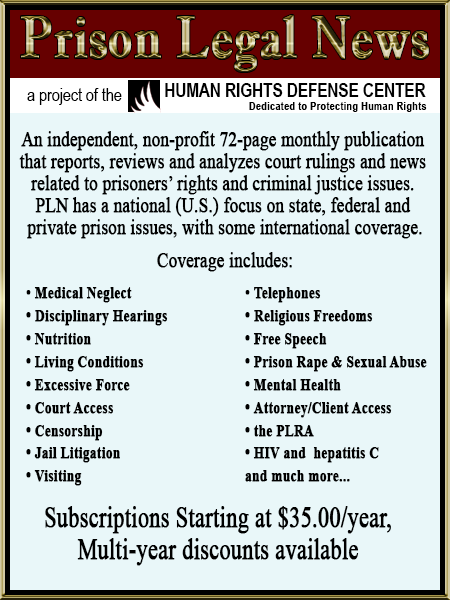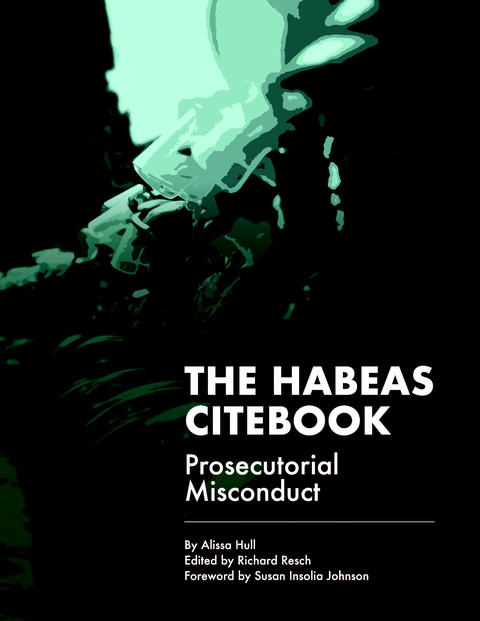Report: Right to Trial Exists in Name. In Reality, Only 3% of Cases Go to Trial
by Steve Horn
The Sixth Amendment to the U.S. Constitution guarantees a right to trial by jury, but a new report documents that in the U.S. criminal justice system, trials have become the rare exception — not the rule.
“The Trial Penalty: The Sixth Amendment Right to Trial on the Verge of Extinction and How to Save It” was published in July by the National Association of Criminal Defense Lawyers (“NACDL”).
It has added to the volumes of scholarship on the topic, concluding that the right to a jury trial in criminal courts has all but gone extinct in the United States. In more precise terms, the report says only about 3 percent of criminal court cases go to trial, with the rest put to bed via plea bargaining.
The “trial penalty,” details the report, “results from the discrepancy between the sentence the prosecutor is willing to offer in exchange for a guilty plea and the sentence that would be imposed after a trial.”
“If there were no discrepancy at all, there would be far less incentive for defendants to plead guilty. But the gap between post-trial and post-plea sentences can be so wide, it becomes an overwhelming influence in a defendant’s consideration of a plea deal,” reads the report. “When a prosecutor offers to reduce a multi-decade prison sentence to a number of years — from 30 years to 5 years, for example — any choice the defendant had in the matter is all but eliminated.”
This trend, the report concludes, has bolstered the hands of prosecutors and disempowered both criminal defense attorneys and democracy itself. The report says democracy at large is at stake because citizens, as a result of pretrial plea bargains, have become less involved in the criminal justice system with the accompanying inability to serve on juries.
The report also concludes that it makes criminal defense lawyers less competent at their jobs and more akin to plea-deal brokers, with prosecutors also getting worse at their jobs and more prone to sloppy work. The current system allows for this sloppiness to be settled pretrial before the full facts are discovered or heard by a jury at a trial, giving prosecutors an inherent advantage in criminal cases.
It is a problem long in the making, the report shows through the painstaking history of jurisprudence on the issue and one that has reached a crisis level.
“Once the centerpiece of our criminal justice ecosystem, the trial is now spotted so infrequently that if we don’t do something to bring it back, we will need to rethink many other features of our system that contribute to fair and just results only when trials occur in meaningful numbers,” the report explains. “Our Constitution claims to protect the guilty as well, affording them a presumption of innocence and protecting them from punishment unless the government can prove them guilty beyond a reasonable doubt. A system characterized by extravagant trial penalties produces guilty pleas in cases where the government cannot satisfy that burden, hollowing out those protections and producing effects no less pernicious than innocents pleading guilty.”
Indeed, the report points out, innocent people often plead guilty in criminal cases because they know they could potentially get harsher charges and more time in prison if they take the case to a trial by jury. Explicit threats of that, in fact, are perfectly legal under U.S. Supreme Court case law.
“Exoneration research has revealed one of the most tragic aspects of the criminal justice system: The pressure [that] defendants face to plead guilty can even cause innocent people to plead guilty,” the report chronicles. “Of the 354 individuals exonerated by DNA analysis, 11% had pled guilty to crimes they did not commit, and the National Registry of Exonerations has identified 359 exonerees who pled guilty.”
Draconian Guidelines
The “trial penalty” problem is also exacerbated, says the report, due to draconian federal sentencing guidelines and the policy of mandatory minimum sentences.
“Today, the Federal Rules of Criminal Procedure explicitly recognize and sanction plea bargaining. In exchange for a defendant’s agreement to plead guilty, prosecutors may offer to not bring certain charges or to dismiss certain charges,” explains the report. “They may agree to recommend, or not to oppose, a particular sentence or sentencing range. In addition, they may agree to argue for or against the application of particular sentencing factors. The flip side of all of these options is that prosecutors may also threaten to add charges or to recommend increased sentences if defendants refuse to plead guilty.”
Historically, the issue is nothing new, something grappled with in various courts all the way up to the U.S. Supreme Court.
As a root cause of this situation, the report cites the U.S. Supreme Court case Santobello v. New York (1971), which concluded: “If every criminal charge were subjected to a full-scale trial, the States and the Federal Government would need to multiply by many times the number of judges and court facilities.”
Santobello was the first in a line of cases locking in the “trial penalty” and making it the law of the land. Put another way, Santobello locked in the legal precedent that efficient case flow for courts and judges has risen above the need to ensure that every defendant has a guaranteed day in court in front of a jury if he or she so desires, as guaranteed by the Sixth Amendment.
After Santobello, in 1978 the U.S. Supreme Court decided the case Bordenkircher v. Hayes, in which the high court gave its blessing to use the threat of more severe charges being brought by a prosecutor as a bargaining tactic during the plea bargaining process.
“There is no doubt that the breadth of discretion that our country’s legal system vests in prosecuting attorneys carries with it the potential for both individual and institutional abuse,” the Court observed in Bordenhircher. “And broad though that discretion may be, there are undoubtedly constitutional limits upon its exercise. We hold only that the course of conduct engaged in by the prosecutor in this case, which no more than openly presented the defendant with the unpleasant alternatives of forgoing trial or facing charges on which he was plainly subject to prosecution, did not violate the Due Process Clause of the Fourteenth Amendment.”
‘Trial Penalty’ Analyzed
In addition to NACDL’s use of the term ‘trial penalty,’ it has actually been repeatedly used within academia. For example, in 2014 it was pointed to as problematic in Virginia’s state criminal court system in a paper titled, “Sentencing Roulette: How Virginia’s Criminal Sentencing System is Imposing an Unconstitutional Trial Penalty That Suppresses the Rights of Criminal Defendants to a Jury Trial,” published by the William & Mary Bill of Rights Journal.
A year earlier, David Abrams – a law professor at the University of Pennsylvania – spawned his own debate about the “trial penalty” in his paper aptly titled, “Putting the Trial Penalty on Trial.” Published in his law school’s Legal Scholarship Repository journal, Abrams argued in the paper it was time for a deeper dive look into the “trial penalty” and that the data he reviewed showed that – contrary to popular belief – those who go to trial actually end up getting fewer years in prison than those who sign onto guilty pleas. Abrams has gone so far as to call the “trial penalty” a “myth.”
“The empirical evidence shows little support for the trial penalty, and in fact there appears to be a plea penalty,” Abrams concluded. “Expected sentences are at least one year longer in plea bargains than in trials, and incarceration is also about twice as likely to result.”
Abrams also wrote that defense attorneys may often have their own incentive to settle cases quickly with one client and move onto their next payday with another, which runs counter to the best interests of the former client.
“There are certainly cases in which it is in the defendant’s best interest to take a plea deal, but on the average, going to trial should be considered more heavily by both attorneys and defendants,” posited Abrams. “Defense attorneys may wish to consider presenting clients with statistics on the relative outcomes of pleading and going to trial, in order to allow them to make more informed decisions. Greater rotation of court staff may also mitigate the natural desire of attorneys to maintain good collegial relations.”
Recommendations
In its recommendations, NACDL calls for an end to mandatory minimum sentencing as well as an end to the Bordenhircher precedent and writes that “defendants should have full access to all relevant evidence, including any exculpatory information, prior to entry of any guilty plea.” The latter would get rid of the “informational advantage” NACDL says prosecutors have under the “trial penalty” regime.
As it stands, “defendants presented with plea offers are often at an informational disadvantage and are unable to adequately assess the likelihood that they could be acquitted of the charges the prosecutor has selected, even with the benefit of effective assistance of counsel,” the report concludes, thus calling for an end to that arrangement.
Writing about the “trial penalty” months before NACDL unveiled its report, U.S. District Court Judge Robert Conrad and his Clerk, Katy Clements, pointed out in a paper that plea bargaining has become about as normal to the legal system as being in the water is to fish.
“The overarching expectation within the criminal legal landscape is that trials are outliers and plea agreements are the norm,” wrote Conrad and Clements in their January 2018 paper titled, “The Vanishing Criminal Jury Trial: From Trial Judges to Sentencing Judges,” published in The George Washington University Law Review. “Plea agreements are so entrenched in our system that we do not notice the absence of trials because almost no one goes looking for them anymore.”
If NACDL and its legion of criminal defense attorneys have it their way, the dilemma decried by Conrad and Clements will not last long into the future.
Sources: gwlr.org, scholarship.law.upenn.edu, law.upenn.edu, scholarship.law.wm.edu, supreme.justicia.com, nacdl.org
As a digital subscriber to Criminal Legal News, you can access full text and downloads for this and other premium content.
Already a subscriber? Login





